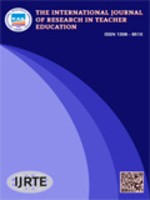Pre-Service Science Teachers’ Views About A Two-Column-Writing Activity
Bilgi ve teknoloji çağını yaşadığımız günümüzde yüksek öğretimin amaçlarından biri yaşam boyu öğrenme becerilerine sahip bireyler yetiştirmektir. Bu amaca ulaşmak için bireylerin üst düzey düşünme becerilerinin geliştirilmesi büyük önem arz etmektedir. Üst düzey düşünme becerilerinden biri yansıtıcı düşünmedir ve iki kolonlu yazılar yansıtıcı düşünmeyi geliştirmek amacıyla kullanılabilecek yaklaşımlardan biridir. Bu çalışmada birinci sınıfta öğrenim görmekte olan 10 fen bilgisi öğretmen adayının iki kolonlu yazı uygulamasına yönelik görüşlerini belirlemek amacıyla yarı yapılandırılmış mülakatlar kullanılmıştır. Çalışmanın sonuçları çoğu öğretmen adayının iki kolonlu yazılara yönelik olumlu görüşleri bulunduğunu göstermektedir. Bununla birlikte iki kolonlu yazıların özet veya yansıtıcı günlük bölümünden yararlanamadığını belirten öğretmen adayları da vardır. Öğretmen adayları iki kolonlu yazılarda yaptıkları yansıtmaların çalışma yöntemleri konusunda bilgi sahibi olmalarını sağladığını ve öğrenmeleri ile ilgili eksiklikleri tespit ederek çözümler üretmelerini sağladığını belirtmişlerdir. Bununla birlikte çalışmanın sonuçları yansıtma seviyesi düşük olan öğretmen adaylarının yansıtıcı günlüklerden yararlanamadığını göstermiştir. Çalışmanın sonuçlarına dayalı olarak öneriler yapılmıştır.
Anahtar Kelimeler:
İki kolonlu yazı, yansıtma, yansıtıcı düşünme, yansıtma seviyesi, fen bilgisi öğretmen adayları
Pre-Service Science Teachers’ Views About A Two-Column-Writing Activity
In the age of science and technology one of the aims of higher education is developing individuals’ lifelong learning abilities. To achieve this aim it is important to develop individuals’ higher order thinking skills. One of the higher order thinking skills is reflective thinking, and two-column writing is one of the ways of developing reflective thinking. The purpose of this study is to determine 10 first grade pre-service science teachers’ views about twocolumn writing process. A semi-structured interview protocol was developed and employed to collect data. Findings of the study showed that most of the pre-service science teachers are positive regarding to two-column writing process. However, a few pre-service teachers indicated that they could not benefit from either the or the reflective journal part of the two-column writings. The pre-service teachers stated that keeping reflective journals help them gain information about their learning styles and determine their learning deficiencies and find solutions for them. In addition, the results showed that the pre-service science teachers, who earned lower reflection level scores from their journals, do not see and appreciate benefits of keeping reflective journals. In further research it is suggested that a combination of teaching methods should be employed to develop reflection skills of pre-service science teachers whose reflection level is low and the assignments should be scored to encourage pre-service science teachers to prepare the assignments properly.
Keywords:
Two-column writing, reflection, reflective thinking, reflection level, pre-service science teachers,
___
- Amodeo, J. L. (1996). The Effect of Guided Journal Writing on Community College Students of Technology, Doctoral Dissertation, University of Toronto, Canada.
- Bryce, J., & Withers, G. (2003). Engagaing Secondary School Students in Lifelong Learning. Melbourne: Australian Council for Educational Research.
- Budak, Y. (2009). Yaşam boyu öğrenme ve ilköğretim programlarının hedeflemesi gereken insan tipi. Gazi Eğitim Fakültesi Dergisi, 29(3), 693-708.
- Cengiz, C., Karataş, F. Ö., & Yadigaroğlu, M. (2013, 5-8 February). The investigation of pre-service science teachers’ reflective journals. 5 th World Conference on Educational Sciences. Sapienza University of Rome, Italy.
- Deneme, S. (2009). İngilizce öğretmen adaylarının özetleme stratejilerini kullanım tercihleri. Journal of Language and Linguistic Studies, 5(2), 85-91.
- Erdamar Koç, G. (2010). “Yaşam Boyu Öğrenme”. Eğitimde Yeni Yönelimler (edit: Özcan Demirel). PegemYayıncılık, Ankara.
- Göksan, T. S.,Uzundurukan, S., & Keskin, S. N. (2009, 67 Kasım). Yaşam Boyu Öğrenme ve Avrupa Birliği’nin Yaşam Boyu Öğrenme Programları. 1. İnşaat Mühendisliği Eğitimi Sempozyumunda sunulan bildiri, Antalya.
- Grant, A., Kinnersley, P., Metcalf, E., Pill, R., & Houston, H. (2006). Students’ views of reflective learning techniques: An efficacy study at a UK medical school. Med Educ, 40(4), 379-388.
- Kozan, S. (2007). Yansıtıcı Düşünme Becerisinin Kaynak Tarama ve Rapor Yazma Derslerindeki Etkisi. Yayınlanmamış Yüksek Lisans Tezi, Selçuk Üniversitesi, Sosyal Bilimler Enstitüsü, Konya. Langer, A. M. (2002). Reflecting on practice: using learning journals in higher and continuing education. Teaching in Higher Education, 7(3), 337-351.
- Malthouse, R. &Roffey-Barentsen, J. (2013). Reflective Practice in Education and Training. London: Sage Publications.
- Moffitt,G. (2000). Dialogue Journals In The Science Classroom: A Case Study, Master Thesis of Education, TheUniversity of New Burnswick, Canada.
- Moon, J. (2006). Learning Journals. New York:Routledge.
- Park, C. (2003). Engaging students in the learning process: the learning journal. Journal of Geography in Higher Education, 27(2), 183-199.
- Sönmez, V. (2010). Öğretim İlke ve Yöntemleri. Ankara: AnıYayıncılık.
- Stefani, L., Clarke, J., & Littlejohn, A. (2000). Developing a student-centred approach to reflective learning. Innovations in Education and Training International, 37(2), 163-171.
- Tok, Ş. (2008a). The effects of reflective thinking activities in science course on academic achievements and attitudes toward science. Elementary Education Online, 7(3), 557-568.
- Tok, Ş. (2008b).The impact of reflective thinking activities on student teachers’ attitudes toward teaching profession, performance and reflections.Education and Science, 33(149), 104-117.
- Wilson, J.,& Jan, L.W. (1993). Thinking for Themselves: Developing Strategies for Reflective Learning. Australia: Eleanor Curtain Publishing.
- ISSN: 1308-951X
- Başlangıç: 2010
- Yayıncı: Eğitim Araştırmaları Birliği Derneği
